As Hurricane Milton moves toward Florida’s Gulf Coast, people are preparing for what experts say could be the worst storm in over 100 years. With huge storm surges and strong winds expected, the region is on high alert, and evacuation orders are being issued.
Hurricane Milton is gaining strength fast, and experts warn it could be one of the most dangerous storms in recent times. Many areas are already vulnerable due to past storms, increasing the risk of widespread damage and flooding.
Evacuation orders are in place, and officials are urging people to take the storm seriously and prepare for life-threatening conditions. Safety is the main focus as the storm approaches, and the next few days will be crucial for those in its path.
### Hurricane Milton: A Record-Breaking Storm
Hurricane Milton has grown into a Category 5 storm, one of the most dangerous types on the Saffir-Simpson scale. With winds over 157 mph, it could cause massive destruction along its path.
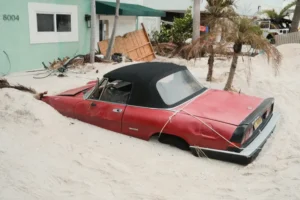
The National Hurricane Center warns that homes could be destroyed, trees and power lines will fall, and some places might not be livable for weeks or even months. They said, “A high percentage of framed homes will be destroyed, with total roof failure and wall collapse.”

Storm surges could be especially bad, with water levels rising up to 12 feet in some areas. This could be the worst surge the Tampa Bay area has seen in nearly 100 years. Just weeks ago, Hurricane Helene caused floods with an 8-foot water surge.
Milton is expected to bring even worse flooding. While the storm may weaken to a Category 3 by the time it hits Florida, it will still be dangerous. With winds up to 129 mph, even strong homes could suffer major roof damage, and trees are likely to be uprooted.
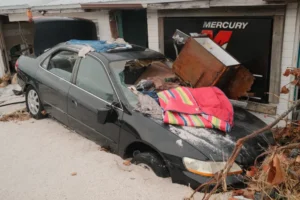
Many are comparing Milton to past hurricanes like Irma (2017) and Betsy (1965). But what makes Milton particularly dangerous is the debris left behind by Hurricane Helene, which could worsen the damage.
### Warnings from Officials: The Call to Evacuate
As the hurricane nears, local authorities are giving strong warnings to people in at-risk areas. Tampa Mayor Jane Castor warned, “[If you] stay in one of those evacuation areas, you’re gonna die.”

She said that while past storms like Hurricane Helene were bad, Milton could bring destruction on a whole new level. Pinellas County Sheriff Bob Gualtieri echoed this, calling for the largest evacuation since Hurricane Irma in 2017.
“This is going to be bad. Everyone just needs to get out,” he said. Governor Ron DeSantis also spoke of the risks, saying, “There are areas with a lot of debris… if hit by a major hurricane, it’s going to dramatically increase damage.”

Evacuation orders are in place, and local authorities stress that those who don’t leave will be on their own when the storm hits. Many who stayed behind in past hurricanes are now taking these warnings seriously.
### Evacuation Efforts in Full Swing
With Hurricane Milton approaching Florida’s Gulf Coast, evacuation efforts are in motion. Local authorities have ordered mandatory evacuations for several coastal communities, urging people to leave before it’s too late.
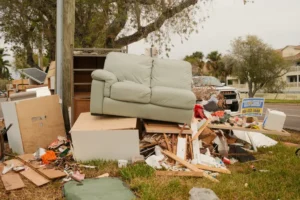
Traffic is heavy on highways as thousands of residents move inland to escape the storm. On Interstate 75, northbound lanes were packed with cars heading toward the Florida Panhandle.
Others sought shelter in places like Fort Lauderdale and Miami, which are expected to be less affected. Meanwhile, southbound lanes were nearly empty. Communities hit hard by past storms aren’t taking chances this time.
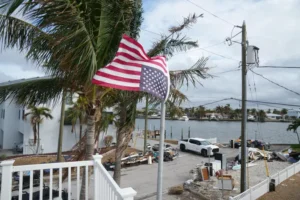
In Fort Myers Beach, a town devastated by Hurricane Ian two years ago, streets were empty as residents packed up and left, with only a few people staying behind to secure their homes.
Those who remember the severe flooding caused by Ian’s 15-foot storm surge know the danger is real and are taking steps to avoid a repeat of past tragedies.
As Hurricane Milton nears, people in high-risk areas need to know their evacuation zones and routes. The Florida Division of Emergency Management has a “Know Your Zone” tool, helping residents find their zone by entering their address.

This tool is especially important as evacuation orders continue to come for coastal areas along the Gulf Coast. Several counties are advising residents to check both their evacuation and storm surge zones.
Counties like Hillsborough, Pinellas, Manatee, and Pasco have issued immediate evacuation orders for areas most at risk. Coastal communities in these regions must evacuate quickly.
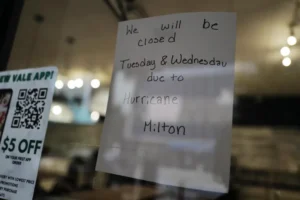
Other counties, like Polk and Highlands, don’t have mandatory evacuations but recommend sheltering in place. Sarasota, Citrus, and Hernando counties are also monitoring storm surge zones for possible evacuations.
Officials emphasize the importance of knowing your evacuation zone and finding the nearest shelters and safe routes. Those who stay may face the full force of the storm, with emergency services likely unavailable once conditions worsen.

The “Know Your Zone” map offers an easy way for residents to plan their safest escape route. By using this resource and acting quickly, people can protect themselves and their families from Hurricane Milton’s potential devastation.
Jennifer Grey felt ”invisible” after facial transformation – her ”nose job from hell” made her ‘anonymous’

The actress who played “Baby” in the beloved movie Dirty Dancing, Jennifer Grey, was expected to see a significant boost in her career possibilities.
That was not to be, though. Instead, a terrible accident changed everything and forced her to give up the movie industry forever.
The terrible period in her life that left Jennifer Grey severely traumatized was finally discussed by the sixty-two-year-old Jennifer Grey after many years.

It’s a low-budget movie without a big name director or celebrity cast.
But when Dirty Dancing opened in theaters in August 1987, the actors and producers realized they had accomplished something truly great.
The primary actor, Patrick Swayze, achieved quick success. He became well-known as a sex icon and teenage hero before going on to appear in big-budget films like Donnie Darko and Ghost.
But when the movie first came out, his co-star Jennifer Grey wasn’t feeling well, so she swiftly disappeared from sight. Jennifer Grey disappeared amidst the chaos and celebrations just as quickly as she had appeared.

In addition, the actress spent a considerable amount of time away from the spotlight.
Nonetheless, in a recent interview with People Magazine, she revealed every detail of the accident that changed her life.
First, let’s take a look at Jennifer Grey’s life leading up to the tragic event that happened in the summer of 1987.
Jennifer Gray began taking dancing classes at a young age. Her father most likely urged her to seek a career in entertainment when she was born in New York in 1960. Her father, Joel Gray, was an actor, director, photographer, dancer, and vocalist.
Jennifer attended the Dalton School to study dancing and acting. After graduation in 1978, she began seeking acting roles, and she went on to study at the Neighborhood Playhouse School of the Theater. But it wasn’t a rose-colored dance in her life. Jennifer had to work as a waitress to pay the bills.
She did, however, manage to get a couple of TV commercials, including one for Dr. Pepper. Her first motion picture role was in 1984’s “Reckless.” A few years later, she had an incredible breakout role in “Dirty Dancing,” where she played Frances “Baby” Houseman.

The cherished film’s narrative is based on scriptwriter Eleanor Bergstein’s early years. Jennifer became well-known overnight and received a Golden Globe nomination for Best Actress.
Sad event
Unfortunately, she was never able to enjoy the enormous success.
Just before the movie’s August 1987 premiere, Grey and her then-boyfriend Matthew Broderick were residing in Ireland.
But Broderick was driving on the wrong side of the road when he struck another car, and the pair was involved in a horrifying auto accident. A woman and her daughter were killed instantly when they were in the other car.

Eventually, Broderick’s charges of careless driving were withdrawn. In contrast, Jennifer Grey only suffered minor bumps and bruises, but her psychological scars remained.
A few days later, Dirty Dancing had its premiere. Nevertheless, Grey was unable to enjoy the success of the film.
In the middle of such severe sadness and survivor’s guilt, it just didn’t feel right to be heralded as the next big thing. “It didn’t feel good to be the toast of the town,” Grey reportedly said, according to the Daily Mirror.

The actress’s anguish from the accident will never fully go away.
“My ambition and my head were never the same,” she told People.
The most awful nose job ever
Her struggle with survivor’s guilt caused her to disappear for a while in the early 1990s, but she reappeared in a single Friends episode in 1995.
By then, she had undergone plastic surgery, and her face was radically altered.
“I entered the operating room as a celebrity and left anonymous,” she said in 2012.

It was like being undercover or covered by witness protection. The worst nose job I’ve ever seen. I’ll always be this once-famous actress that nobody knows about because of a nose job.
Jennifer’s Hollywood career was sporadic after that.
By 2010, Jennifer had made a successful comeback to the mainstream media. She was a hit with the public once more after winning “Dancing with the Stars.” She said that was something that was important to her.

I feel like I’ve starved myself out of concern for what people may think of me. “This is like having a delicious steak after 23 years on a diet,” the actor said to People.
In 2018, Grey took another step toward the limelight she had previously left behind. She is expected to star in the upcoming motion picture Untogether and comedy Red Oaks.

Jennifer, we’re so happy to see you back to your passionate, happy self!
Who else has a strong need to go back in time to 1987 at this point? Watch the classic scene from Dirty Dancing down below. What beautiful memories!
Please share this news with your friends on Facebook. Like me, they probably watched Dirty Dancing and wondered what happened to the gorgeous Jennifer Grey!



Leave a Reply